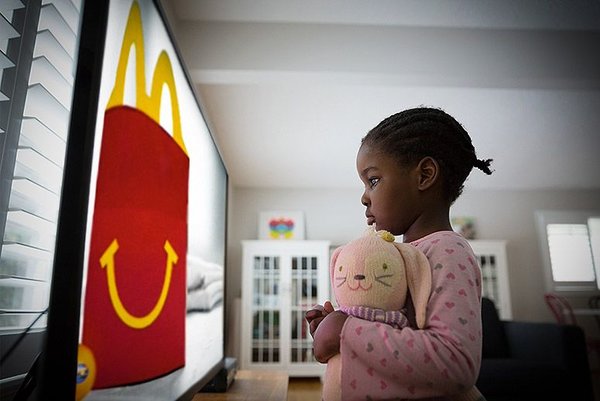Activists say strict bans should be enacted to counter ads for items high in fat, salt, and sugar.
Television commercials featuring the Kool-Aid Man, the newest cereal flavor, or McDonald’s latest Happy Meal toy are common sights during Saturday-morning cartoons. But two studies published last week suggest that the barrage of junk-food advertisements on television is a driving factor behind rising childhood obesity levels. Some health experts believe the days of junk-food advertisements being shown during times children are probably watching should come to an end.
“We face a huge public health crisis related to our children’s diet, and children are uniquely vulnerable to advertising,” Josh Golin, executive director of Campaign for a Commercial-Free Childhood, wrote in an email to TakePart. “The best way to improve kids’ diets is by forcing food and beverage companies to market directly to parents and leave kids out of the equation.”
For one study, published in the July 2016 Obesity Review, researchers from McMaster University in Ontario, Canada, conducted randomized trials and found that children who saw commercials for junk foods consumed more unhealthy foods than healthy ones.
Those findings are supported by a study released by the National Centre for Social Research in London on behalf of Cancer Research UK. It analyzed kids’ responses to junk-food commercials on TV and found that children commonly ask their parents to purchase items that they see on-screen. Although they’re aware of the benefits of a healthier diet—and that the junk foods shown in the commercials aren’t good for them—kids told the researchers the ads for unhealthy treats still tempt them.
Meanwhile, there are roughly 41 million obese or overweight children under the age of five globally, according to the World Health Organization. Research has also shown that obese children are more likely to be obese as adults, increasing their risk of heart disease and cancer. Doctors and health advocates have long been concerned about how advertisements for chips, candy bars, and other junk foods affect these rates.
Johnson’s team said these findings are important considering other research has found youngsters are exposed to an average of five commercials for salt-, sugar-, and fat-laden food per hour of screen time. In Canada and the United States, commercials for these foods make up roughly 80 percent of all food advertisements.
“I don’t normally think of [sweet], but when I see [sweet], I just want them!” one girl told the U.K. researchers about the effect the commercials have on her.
While the U.K. banned unhealthy food advertisements from being shown during children’s shows in 2006, kids still see them when family programming is aired. As a result, last fall, health activists and some members of Parliament urged lawmakers to prohibit junk-food commercials during all television programming before 9 p.m.
The U.K. study concluded that if reducing the intake of foods high in fat, salt, and sugar is the goal, exposure to them through commercials needs to be reduced.
“It’s clear the restrictions already in place during children’s TV shows aren’t enough,” Alison Cox, director of prevention at Cancer Research UK, said in a statement. “Children are watching junk food adverts during family programs where these restrictions don’t apply.”
As for the United States, Golin wrote that every time federal agencies have advocated for changes to food-commercial regulations, industry lobbyists have pushed back, and legislators have sided with food companies. That means kids continue wanting—and eating—the candy, chips, soda, and fast-food products they see on television.
“Junk food marketers know that if they can reach children when they are young, they can help set food preferences for life,” Golin wrote. “When you think about it, there’s not much actual difference between, for example, Coke and Pepsi. So it’s very important for corporations to get kids to form emotional attachments to their brands.”
Source: Take Part
Women of Green is TURNING UP THE VOLUME of the feminine voice on the planet in order to create the world we know is possible.
